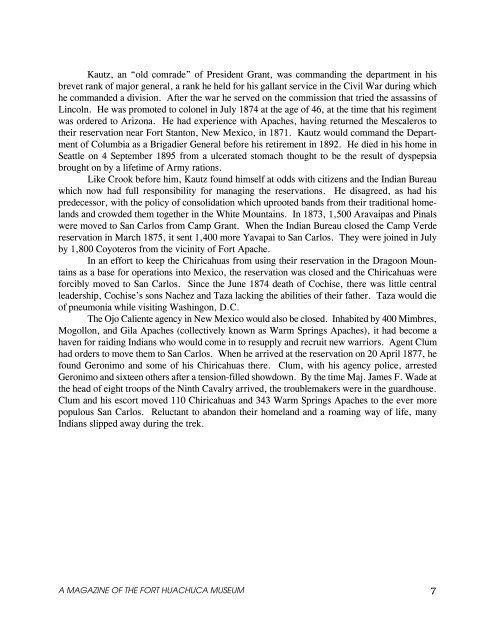Apache Campaigns - Fort Huachuca - U.S. Army
Apache Campaigns - Fort Huachuca - U.S. Army
Apache Campaigns - Fort Huachuca - U.S. Army
Create successful ePaper yourself
Turn your PDF publications into a flip-book with our unique Google optimized e-Paper software.
Kautz, an “old comrade” of President Grant, was commanding the department in his<br />
brevet rank of major general, a rank he held for his gallant service in the Civil War during which<br />
he commanded a division. After the war he served on the commission that tried the assassins of<br />
Lincoln. He was promoted to colonel in July 1874 at the age of 46, at the time that his regiment<br />
was ordered to Arizona. He had experience with <strong>Apache</strong>s, having returned the Mescaleros to<br />
their reservation near <strong>Fort</strong> Stanton, New Mexico, in 1871. Kautz would command the Department<br />
of Columbia as a Brigadier General before his retirement in 1892. He died in his home in<br />
Seattle on 4 September 1895 from a ulcerated stomach thought to be the result of dyspepsia<br />
brought on by a lifetime of <strong>Army</strong> rations.<br />
Like Crook before him, Kautz found himself at odds with citizens and the Indian Bureau<br />
which now had full responsibility for managing the reservations. He disagreed, as had his<br />
predecessor, with the policy of consolidation which uprooted bands from their traditional homelands<br />
and crowded them together in the White Mountains. In 1873, 1,500 Aravaipas and Pinals<br />
were moved to San Carlos from Camp Grant. When the Indian Bureau closed the Camp Verde<br />
reservation in March 1875, it sent 1,400 more Yavapai to San Carlos. They were joined in July<br />
by 1,800 Coyoteros from the vicinity of <strong>Fort</strong> <strong>Apache</strong>.<br />
In an effort to keep the Chiricahuas from using their reservation in the Dragoon Mountains<br />
as a base for operations into Mexico, the reservation was closed and the Chiricahuas were<br />
forcibly moved to San Carlos. Since the June 1874 death of Cochise, there was little central<br />
leadership, Cochise’s sons Nachez and Taza lacking the abilities of their father. Taza would die<br />
of pneumonia while visiting Washingon, D.C.<br />
The Ojo Caliente agency in New Mexico would also be closed. Inhabited by 400 Mimbres,<br />
Mogollon, and Gila <strong>Apache</strong>s (collectively known as Warm Springs <strong>Apache</strong>s), it had become a<br />
haven for raiding Indians who would come in to resupply and recruit new warriors. Agent Clum<br />
had orders to move them to San Carlos. When he arrived at the reservation on 20 April 1877, he<br />
found Geronimo and some of his Chiricahuas there. Clum, with his agency police, arrested<br />
Geronimo and sixteen others after a tension-filled showdown. By the time Maj. James F. Wade at<br />
the head of eight troops of the Ninth Cavalry arrived, the troublemakers were in the guardhouse.<br />
Clum and his escort moved 110 Chiricahuas and 343 Warm Springs <strong>Apache</strong>s to the ever more<br />
populous San Carlos. Reluctant to abandon their homeland and a roaming way of life, many<br />
Indians slipped away during the trek.<br />
A MAGAZINE OF THE FORT HUACHUCA MUSEUM<br />
7

















